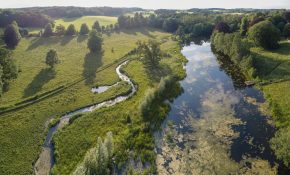New River Full of Fish
Wednesday July 15th, 2015
9 months after the opening of the new mile of river at Bayfield, survey results are showing that six species of fish have moved into their new habitat, and two of those species have already spawned very successfully. The new river was designed by Professor Richard Hey, managed by Tim Jacklin of the Wild Trout Trust and funded by the 9 Chalk Rivers Project.
The most numerous fish found in the survey were brown trout. We found a mix of ages from baby fry to adults of four or five years. The high numbers of fry show that the trout must have spawned in the new gravels shortly after the project was completed. The fry are growing well, showing that there is now plenty of food available.
The next most numerous fish were the bullheads. These are spring-time spawners and had also produced large numbers of young, each less than an inch long at this time of year.
We caught a reasonable number of eels, including six elvers which must have recently arrived from the Sargasso Sea and made their way upstream past the various sluices and weirs. We seem to having a good year for elvers on Glaven and hope this is a good sign for the future.
The biggest surprise was the number of brook lamprey. These creatures spend their early lives in silt on the river bed and we thought they would have been one of the slower species to colonise the new river. We found large numbers of late juveniles in the survey which must have either drifted in with the silt over the winter or actively swum down from upstream.
We also found small numbers of three-spined stickleback and stone loach. As the channel is still new there is little in the way of plant life, tree roots or over-hanging vegetation to shelter the stickleback. We imagine their numbers will increase steadily over the next few years as the habitat evolves and improves. The stone loach is a relatively weak swimmer and presumably a slow coloniser which would also benefit from more shelter in the river. These too should increase in number over the next few years.
Overall we were delighted to see so many species and in such high numbers. Each of the species that we hoped would use the new channel is now there. Early invertebrate surveys show that the insect life is also profuse, and diverse, and the first aquatic plants are starting to take hold. Although we will not know for a few years exactly how well the new channel is working at this point it appears to be a massive success!







